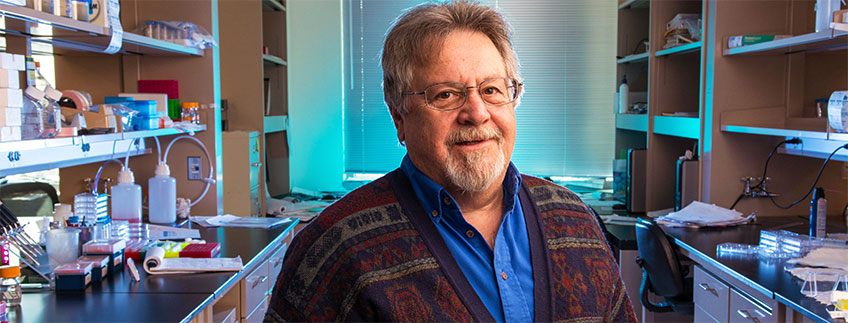Red Wine's Surprising Ingredient
Scientist Finds Grape Skins May Help Prevent Cancer

By Mark Couch
(May 2015) It’s not every day that a cancer researcher gets an interview request from Wine Spectator magazine.
But when your research says that red wine contains a substance that might prevent cancer, you can bet that the phone is going to ring.
Robert Sclafani,
The finding was a bit surprising because alcohol use is known to be a major risk factor for head and neck cancer. But it turns out that the resveratrol found in the skin of grapes used to make red wine has the power to counteract some of the cell-damaging
“Resveratrol challenges these cells,” says Sclafani, a professor of
Still, Sclafani is careful to say that alcohol consumption remains a risk factor. While red wine has resveratrol from the grape skins, other liquors do not contain the beneficial agent. And too much alcohol, even red wine, causes irreparable damage to the genes.
“You’re better off without any alcohol at all,” Sclafani says. “Alcohol bombards your genes. Your body has ways to repair this damage, but with enough alcohol
That resveratrol has a beneficial impact offers some hope for cancer treatments that don’t hit the body as hard as more common therapies, Sclafani says.
Radiation, chemotherapy
“We are looking for something to block it, to prevent that second tumor,” Sclafani says. “The bottom line is maybe we can use this compound found in red wine as a natural therapy.”
In the lab, Sclafani and another scientist on the Anschutz Medical Campus, Rajesh Agarwal, PhD, professor of pharmaceutical sciences at the University of Colorado Skaggs School of Pharmacy and Pharmaceutical Sciences and co-leader of the CU Cancer Center’s Cancer Prevention and Control Program, designed experiments to understand whether there are natural compounds that can improve the body’s resistance.
“Raj studies chemoprevention,” Sclafani says. “If you eat this, is it going to prevent cancer? We’re looking at natural compounds, mostly derived from food. We were using a compound found in the skin of grapes – resveratrol. Peanuts have it too. So do lots of legumes.”
The scientists examined this naturally occurring compound for its effect on cancer cells and in experiments with cells grown in the lab found that resveratrol helped remove those with damaged DNA “with little effect on the normal cell,” he says.
While such findings are potentially helpful for people with head and neck cancers, the findings also hold promise for helping people with Fanconi anemia, a rare genetic disorder that affects about 1 in 300,000 newborns.
Some of what is known about how alcohol causes cancer comes from studies of people with Fanconi anemia, who are prone to leukemia and head and neck cancer. Sclafani learned about Fanconi anemia at meetings of the American Association for Cancer Research.
“When I first heard about it, I had to look it up. And then I thought, ‘I can do something with this. I understand it. This is a problem with DNA repair.’”
People with Fanconi anemia are born without the ability to repair DNA
“With enough alcohol, the body can get behind and end up with a backlog of acetyl aldehyde,” Sclafani says. “Increased exposure to alcohol, loss of the ALDH gene that normally helps the body process alcohol or the loss of the ability to repair DNA
Sclafani met Kenneth Atkinson, MD, a Centennial physician who had two children, Kendall
“It really gets you,” Sclafani says. “His family lost two kids.”
Sclafani has been active in the Kendall and Taylor Atkinson Foundation (KATA), speaking at events and explaining his research, and he has received support for his research from the
The impact of meeting families who support his research keeps the effort in perspective.
“If we can do this, we can make a difference in their lives,” Sclafani says. “You can get lost with the cells in the lab. This brings it all back and you say, ‘Wow, this is really important. We can help these people.’”